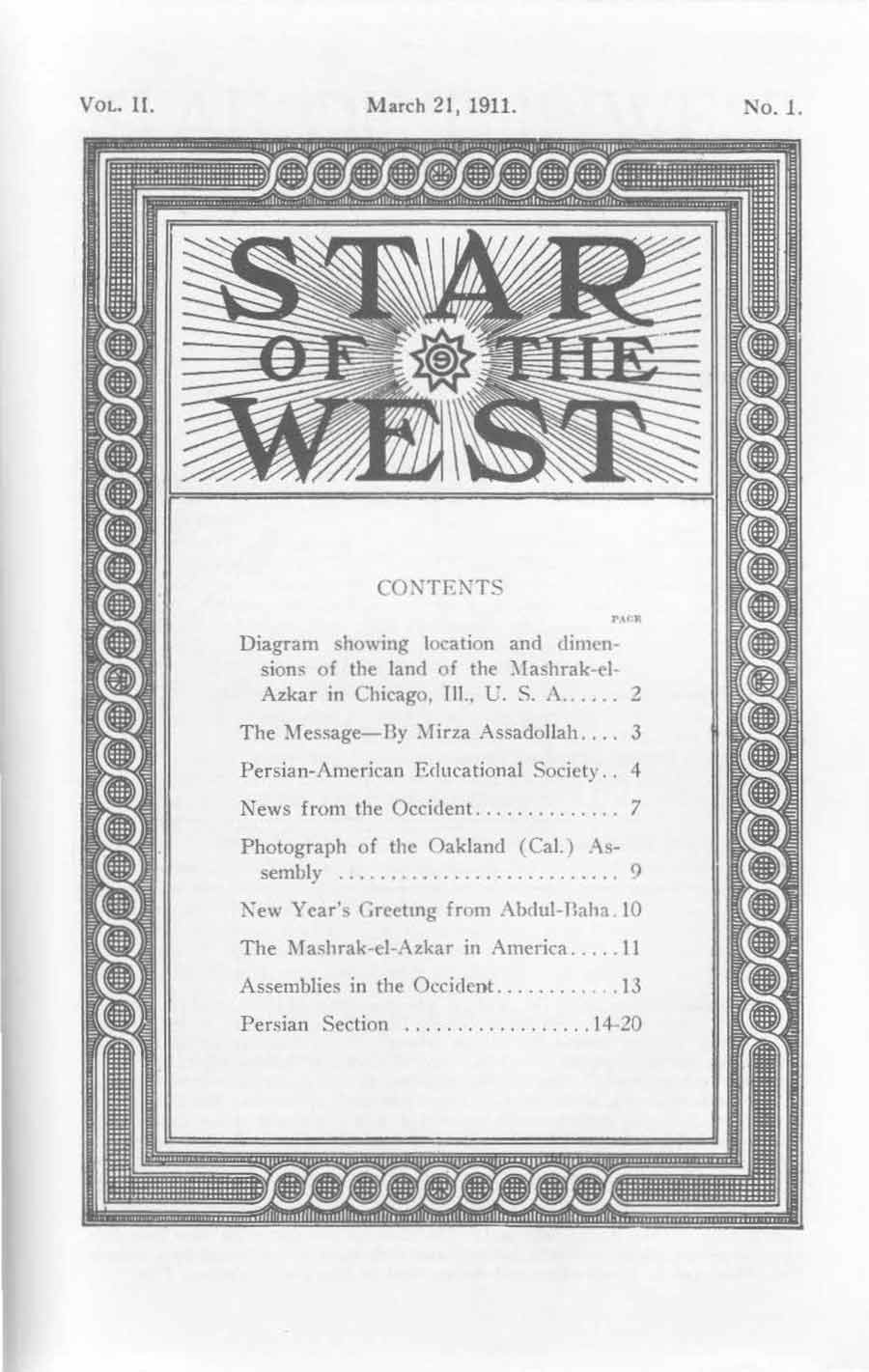One hundred years ago, near the final days of the First World War, the Baha’i world awaited news of the safety of Abdu’l-Baha, given the extension of the theater of war to Haifa.
The Baha’i community was still young but already deeply united despite being scattered across most of the planet. Among the instruments that kept it connected and informed were the nascent news services that had begun to take shape in those early decades of the 20th century.
The news of Abdu’l-Baha’s safety reached that global community through Star of the West, one of the first of the international Baha’i news publications, originally published in 1910 under the name Baha’i News. In 1911, however, it took on its now-iconic title, Star of the West, and in some 20 pages of its first volume under that title covered historic developments in the construction of the Baha’i House of Worship in the United States, published messages from Abdu’l-Baha, and shared reports from around the world.
Star of the West would go on to become one of the first news publications to gain widespread distribution in the then-nascent Baha’i world community. Since that time, international Baha’i news has connected an increasingly global and organically united community, keeping readers abreast of major developments and serving as a valuable instrument for the sharing of new insights and knowledge. Over the years, these publications developed in sophistication and reach, addressing wide audiences and exploring a broad array of topics—and throughout, these Baha’i publications have striven to embody the values contained in the sacred writings of the Faith.
In one of His well-known works, Baha’u’llah described “the pages of swiftly appearing newspapers” as “the mirror of the world” and “an amazing and potent phenomenon,” reflecting “the deeds and the pursuits of diverse peoples and kindreds.” – Baha’u’llah, Fountain of Wisdom, pp. 33-34.
In The Secret of Divine Civilization, initially published anonymously in 1875, Abdu’l-Baha wrote that it was:
… urgent that beneficial articles and books be written, clearly and definitely establishing what the present-day requirements of the people are, and what will conduce to the happiness and advancement of society. These should be published and spread throughout the nation, so that at least the leaders among the people should become, to some degree, awakened, and arise to exert themselves along those lines which will lead to their abiding honor. – p. 109.
In the first issue of Star of the West, editors Albert R Windust and Gertrue Buikema explained that they adopted the name from a phrase used by Abdul-Baha. Encouraging their efforts, Abdu’l-Baha wrote: “thy volume will increase, thy arena will become vast and spacious, and thy voice and fame will be raised and become world-wide …” Not only was Star of the West a vital source of information for Baha’is around the world, but it was also often the first place of widespread publication of writings from Abdu’l-Baha, and, later, Shoghi Effendi.
Star of the West began after an earlier publication, New York Baha’i Bulletin. Believed to be the first English-language Baha’i news publication, New York Baha’i Bulletin published only five issues from September 1908 to May 1909. These early periodicals emerged during a time when the printed word was still the main source of news—radio news would not begin until a decade later. They were developed in contrast to, and in the context of, an evolving media landscape, where, especially in the United States, many editors were printing sensational stories intended to appeal to mass audiences–an approach referred to as “yellow journalism.”
In the following years, other Baha’i communities started their own news publications. In 1917 in Ishqabad, Turkistan, where the world’s first Baha’i House of Worship had recently been built, the Baha’is started Khurshid-i khavar, a news magazine whose name means Sun of the East. In India, a journal called Bahai News started publishing in English and Persian in 1921. That same year in Germany, two publications began, Sonne der Wahrheit, meaning Sun of Truth, and Wirklichkeit, meaning Reality. Then, Akhbar-i-Amri, a publication from Iran whose name means News of the Cause, was first published in 1922. A year later, The Dawn began publishing in Burma, in Burmese, English, and Persian. Herald of the South was a journal for Baha’is in Australia and New Zealand, beginning in 1925. This growth in Baha’i periodicals continued as the Faith spread around the world.
During his ministry as Guardian of the Baha’i Faith, Shoghi Effendi encouraged the publication of national and local newsletters, writing in 1925 that they should aim to report on “matters that are strictly Baha’i in character, as well as … topics of a humanitarian, ethical and religious nature.”
The publication of The Baha’i World in 1926 marked a new stage in the capacity of the Baha’i community to provide reports and statistics, capture experience from diverse countries, and disseminate important insights and analyses. Each edition covered the progress of the international Baha’i community over a defined period.
In 1935, the first volume of World Order magazine was published, including essays, poems, personal recollections, and historical pieces. The periodical brought together into one volume works by scholars, poets, artists, and practitioners from various fields of endeavor. The first volume also included excerpts from a letter by Shoghi Effendi titled “The Goal of a New World Order.”
“A mechanism of world inter-communication will be devised, embracing the whole planet, freed from national hindrances and restrictions, and functioning with marvellous swiftness and perfect regularity,” envisioned Shoghi Effendi in that letter, one of a series written by him between 1929 and 1936.
Today, there has been a proliferation of regional and national Baha’i publications. At the international level, the Baha’i World News Service (BWNS) reports on developments of the worldwide community, and the Baha’i International Community (BIC) covers news relating to efforts at the United Nations and other international forums as well as providing major updates on the persecution of the Baha’i community in Iran and Yemen.
The Baha’i World News Service began publishing online in 2002, picking up the reigns of the former Baha’i International News Service, which was a biweekly printed newsletter. BWNS now also provides podcasts. In the coming months, in addition to English and Persian, stories will be made available in Spanish and French.
In recent years, BWNS has sought not only to inform readers of developments in the Baha’i world but to explore new insights emerging from Baha’i practice—whether at the grassroots level in such areas as social and economic development or in participation in the prevalent discourses of society, through which Baha’i communities are striving to contribute to the advancement of society at the level of thought. At the heart of these efforts has been the exploration of themes central to humanity’s well-being and progress: the equality of women and men, the environment and climate change, the role of religion in society, and migration and integration, to name a few.
Stories about social transformation are gathered from communities around the world and at many different levels of society. While seeking to capture the diversity of the human experience and the particular efforts of a population, the News Service also aims to draw out universal principles and lessons that are applicable and relevant to every society.
As the mechanism of communication envisioned by Shoghi Effendi has been realized, a growing community has increasingly found itself able to connect, remain informed, and draw lessons generated from earnest and sincere efforts of people around the world to apply the teachings of Baha’u’llah for the betterment of their societies. These efforts to make available news to a global community call to mind the words of Abdu’l-Baha in 1875:
The publication of high thoughts is the dynamic power in the arteries of life; it is the very soul of the world. Thoughts are a boundless sea, and the effects and varying conditions of existence are as the separate forms and individual limits of the waves; not until the sea boils up will the waves rise and scatter their pearls of knowledge on the shore of life. – The Secret of Divine Civilization, p. 109.

















Comments
Sign in or create an account
Continue with Googleor